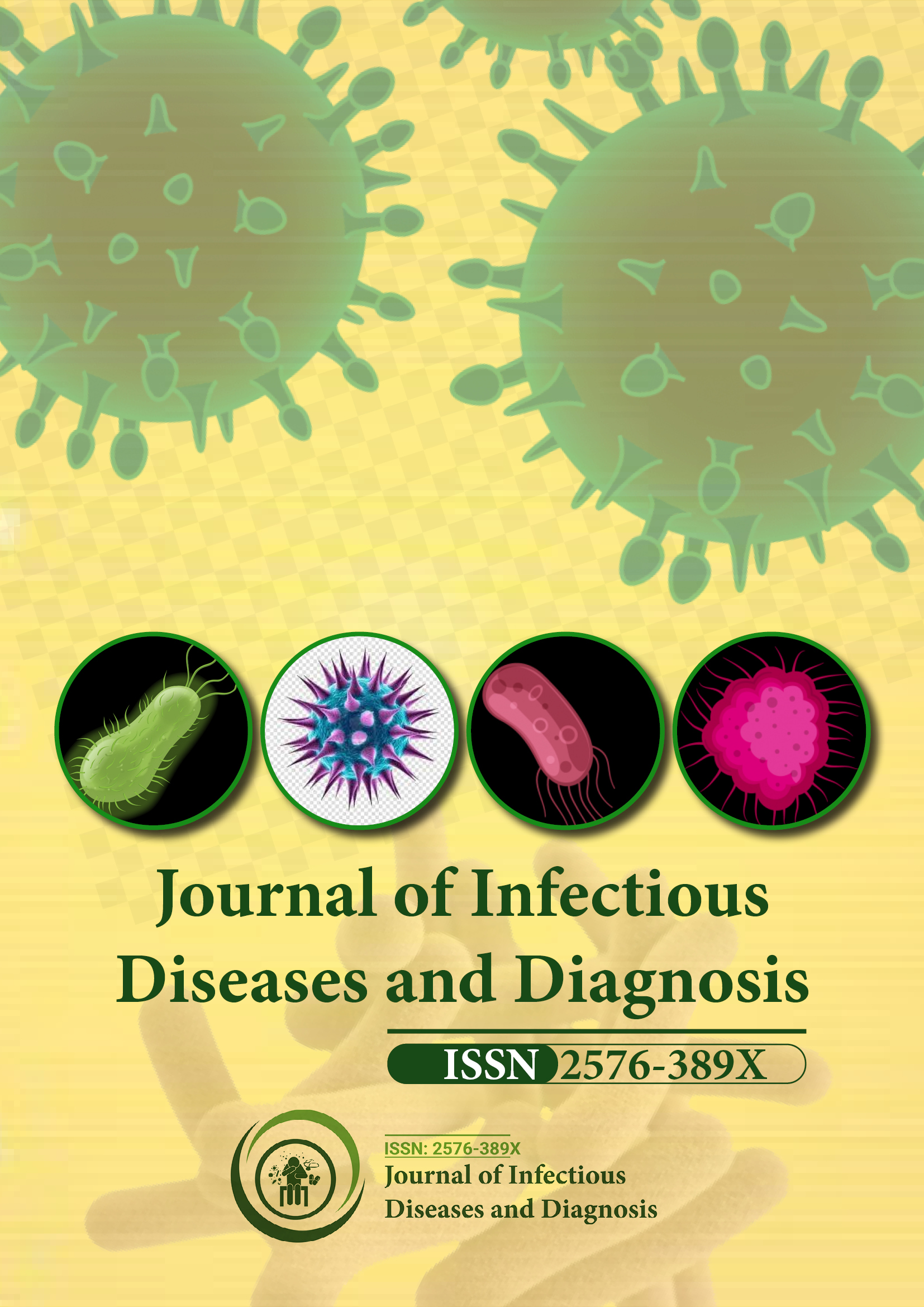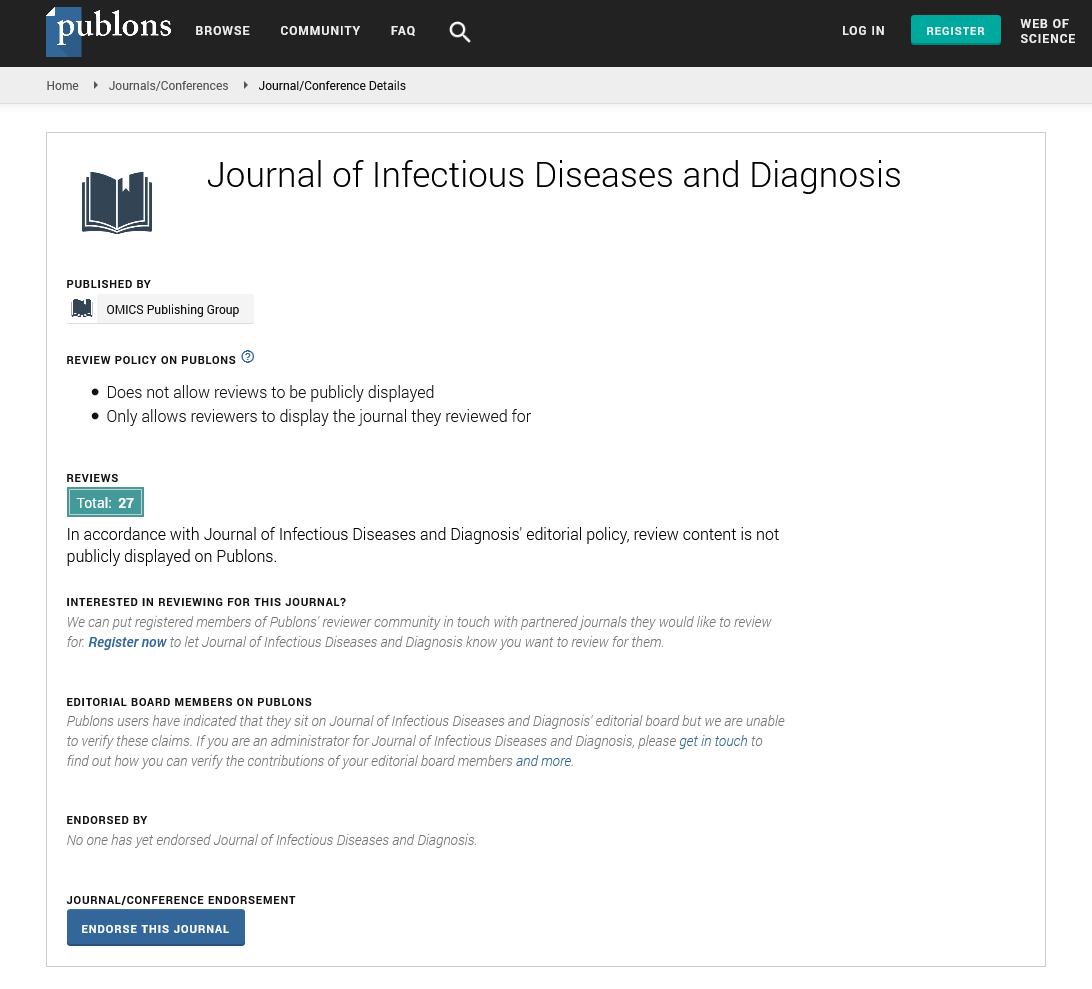Indexed In
- RefSeek
- Hamdard University
- EBSCO A-Z
- Publons
- Euro Pub
- Google Scholar
Useful Links
Share This Page
Journal Flyer

Open Access Journals
- Agri and Aquaculture
- Biochemistry
- Bioinformatics & Systems Biology
- Business & Management
- Chemistry
- Clinical Sciences
- Engineering
- Food & Nutrition
- General Science
- Genetics & Molecular Biology
- Immunology & Microbiology
- Medical Sciences
- Neuroscience & Psychology
- Nursing & Health Care
- Pharmaceutical Sciences
Short Communication - (2024) Volume 9, Issue 5
Diagnostic Challenges and Therapeutic Strategies in Meningitis Management
Righi Vahid*Received: 26-Aug-2024, Manuscript No. JIDD-24-26942; Editor assigned: 29-Aug-2024, Pre QC No. JIDD-24-26942 (PQ); Reviewed: 13-Sep-2024, QC No. JIDD-24-26942; Revised: 20-Sep-2024, Manuscript No. JIDD-24-26942 (R); Published: 27-Sep-2024, DOI: 10.35248/2576-389X.24.09.288
Description
Meningitis is a severe and potentially life-threatening condition characterized by inflammation of the protective membranes (meninges) surrounding the brain and spinal cord. It can be caused by various pathogens, including bacteria, viruses, fungi and parasites, or it can result from non-infectious causes such as autoimmune diseases or drug reactions. The condition is classified into several types based on its etiology, with bacterial and viral meningitis being the most common. Prompt diagnosis and appropriate therapy are important for reducing morbidity and mortality associated with this disease.
Etiology and pathogenesis
The causes of meningitis can be divided into infectious and non- infectious. The most common forms are bacterial and viral, with bacterial meningitis being more severe and viral typically having a more benign course. The bacteria commonly responsible for bacterial meningitis include Neisseria meningitidis, Streptococcus pneumoniae, Haemophilus influenzae and Listeria monocytogenes. These pathogens invade the bloodstream and cross the blood- brain barrier, leading to inflammation.
Viral meningitis, often less severe, is commonly caused by enteroviruses, herpes simplex virus and arboviruses. Non- infectious meningitis can result from autoimmune diseases, cancer, or medications. The pathogenesis of meningitis involves the invasion of pathogens into the Cerebrospinal Fluid (CSF), followed by the host's inflammatory response, which contributes to the symptoms such as fever, headache, neck stiffness and altered consciousness [1-3].
Diagnosis
Early diagnosis is essential to initiating appropriate treatment and improving patient outcomes. The diagnostic process typically begins with a thorough clinical assessment, followed by laboratory investigations.
Lumbar puncture and CSF analysis: A lumbar puncture is the foundation of meningitis diagnosis. The cerebrospinal fluid is analyzed for cell count, glucose, protein levels and the presence of organisms. Bacterial meningitis often presents with elevated white blood cell count (mainly neutrophils), low glucose and elevated protein in the CSF. Viral meningitis usually shows a more moderate elevation in white blood cells (lymphocytes), normal glucose and mildly elevated protein levels.
Gram stain and culture: In bacterial meningitis, Gram staining of the CSF can reveal the presence of bacteria, providing immediate diagnostic information. Cultures of the CSF and blood can help identify the specific bacterial pathogen responsible, guiding targeted antibiotic therapy.
Polymerase Chain Reaction (PCR): PCR is an advanced technique used to detect the genetic material of viruses and bacteria in the CSF, particularly in cases of viral meningitis or when gram staining and culture results are negative.
Imaging studies: In cases where the clinical presentation is unclear or there are concerns about raised intracranial pressure, neuroimaging such as Computed Tomography (CT) or Magnetic Resonance Imaging (MRI) may be used to assess for complications like abscesses or hydrocephalus.
Therapy
The treatment of meningitis varies depending on the underlying cause. Prompt initiation of appropriate therapy is essential to reduce complications and improve survival.
Bacterial meningitis: Bacterial meningitis is a medical emergency that requires immediate antibiotic treatment. Empirical broad-spectrum antibiotics are typically administered while awaiting culture results. Common regimens include third- generation cephalosporins (e.g., ceftriaxone or cefotaxime), vancomycin (for resistant strains of Streptococcus pneumoniae) and ampicillin (for Listeria coverage in older adults). Once the causative organism is identified, antibiotics can be tailored to the specific pathogen. Adjunctive corticosteroid therapy, particularly dexamethasone, may be used to reduce inflammation and prevent complications like hearing loss [4-6].
Viral meningitis: In cases of viral meningitis, treatment is usually supportive, as many cases are self-limiting. Antiviral therapy, such as acyclovir, may be indicated in patients with herpes simplex virus meningitis. Supportive care includes hydration, pain control and antipyretics. Most patients recover without significant long-term effects.
Fungal and parasitic meningitis: Fungal meningitis, such as that caused by Cryptococcus neoformans, is treated with antifungal agents like amphotericin B and flucytosine. Parasitic meningitis, although rare, requires specific antiparasitic therapy. Both types often occur in immunocompromised individuals, such as those with HIV/AIDS and have a more severe prognosis [7,8].
Non-infectious meningitis: The treatment for non-infectious causes of meningitis, such as autoimmune diseases or drug reactions, involves addressing the underlying condition. Corticosteroids or other immunosuppressive agents are commonly used.
Prevention
Vaccination plays a critical role in preventing certain types of meningitis. Vaccines against Neisseria meningitidis, Haemophilus influenzae type b and Streptococcus pneumoniae have significantly reduced the incidence of bacterial meningitis in many parts of the world. Prophylactic antibiotics may also be administered to close contacts of individuals with meningococcal meningitis to reduce the risk of transmission [9,10].
Conclusion
Meningitis is a serious condition that requires prompt diagnosis and appropriate therapy to reduce the risk of complications and death. Advances in diagnostic techniques, such as PCR and the availability of effective vaccines have greatly improved the management and prevention of meningitis. However, early recognition of symptoms and timely intervention remain key to improving outcomes, especially in bacterial meningitis. Compre- hensive strategies including vaccination, rapid diagnosis, and evidence-based treatment protocols are essential to controlling this potentially fatal disease.
References
- Van de Beek D, Brouwer MC, Thwaites GE, Tunkel AR. Advances in treatment of bacterial meningitis. Lancet. 2012;380(9854):1693-1702.
[Crossref] [Google Scholar] [PubMed]
- McGill F, Heyderman RS, Panagiotou S, Tunkel AR, Solomon T. Acute bacterial meningitis in adults. Lancet. 2016;388(10063):3036-3047.
- Tunkel AR, Hartman BJ, Kaplan SL, Kaufman BA, Roos KL, Scheld WM, et al. Practice guidelines for the management of bacterial meningitis. Clin Infect Dis. 2004;39(9):1267-1284.
[Crossref] [Google Scholar] [PubMed]
- Thigpen MC, Whitney CG, Messonnier NE, Zell ER, Lynfield R, Hadler JL, et al. Bacterial meningitis in the United States, 1998-2007. N Engl J Med. 2011;364(21):2016-2025.
[Crossref] [Google Scholar] [PubMed]
- Sáez-Llorens X, McCracken GH. Bacterial meningitis in children. Lancet. 2003;361(9375):2139-2148.
- Granerod J, Crowcroft NS. The epidemiology of acute encephalitis. Neuropsychol Rehabil. 2007;17(4-5):406-428.
[Crossref] [Google Scholar] [PubMed]
- Gundamraj V, Hasbun R. Viral meningitis and encephalitis: An update. Curr Opin Infect Dis. 2023;36(3):177-185.
[Crossref] [Google Scholar] [PubMed]
- Hasbun R, Abrahams J, Jekel J, Quagliarello VJ. Computed tomography of the head before lumbar puncture in adults with suspected meningitis. N Engl J Med. 2001;345(24):1727-1733.
[Crossref] [Google Scholar] [PubMed]
- Posadas E, Fisher J. Pediatric bacterial meningitis: an update on early identification and management. Pediatr Emerg Med Pract. 2018;15(11):1-20.
[Crossref] [Google Scholar] [PubMed]
- Ashwal S, Tomasi L, Schneider S, Perkin R, Thompson J. Bacterial meningitis in children: Pathophysiology and treatment. Neurology. 1992;42(4):739-748.
[Crossref] [Google Scholar] [PubMed]
Citation: Vahid R (2024). Diagnostic Challenges and Therapeutic Strategies in Meningitis Management. J Infect Dis Diagn. 9:288.
Copyright: © 2024 Vahid R. This is an open-access article distributed under the terms of the Creative Commons Attribution License, which permits unrestricted use, distribution, and reproduction in any medium, provided the original author and source are credited.

